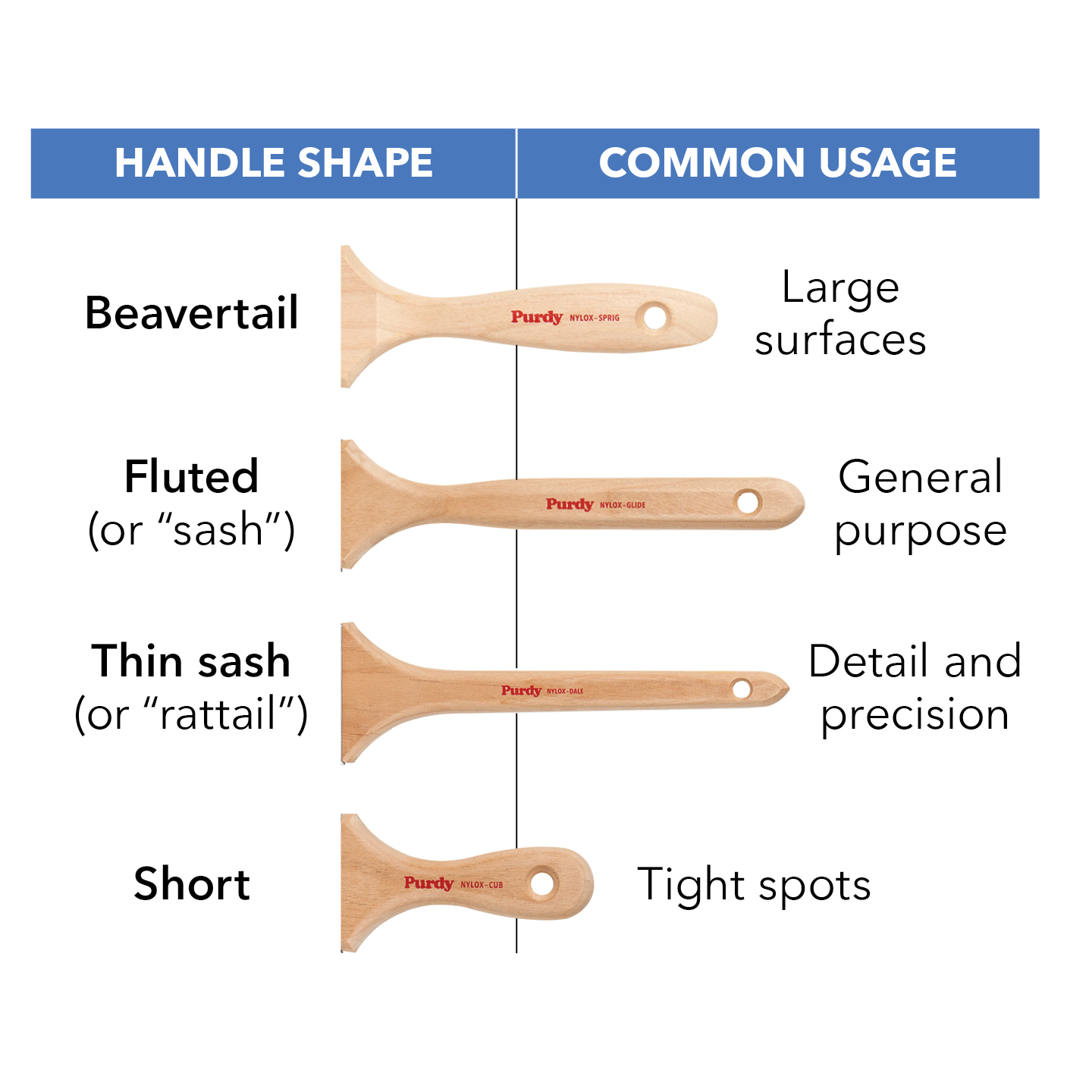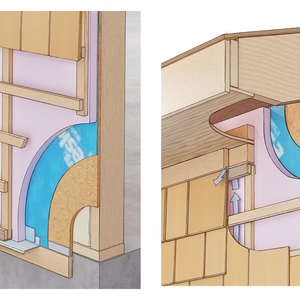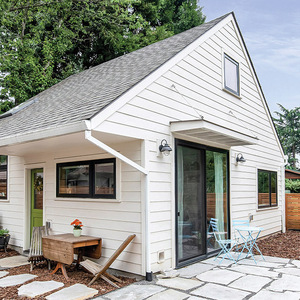Does anyone have any reccommendations for books/videos on door construction. I am interested in building one or two custom entry doors, for fun, for my house, and even for profit.
There are tons of books on hanging and installing doors, but I am looking for info on how to build the door.



















Replies
Commercial doors are made using cope-and-stick cutters and panel moulding knives on big shapers. If you have a heavy-duty half-inch router, a router table, and some patience and ingenuity, you can use this method at home.
The frames of traditional custom doors are made with mortise and tenon joints. You can do this type of joint using a tenoning jig on your table saw and a plunge router and hand-chisel to cut and square the mortises. You will have to profile the panels by hand with a plane or you may want to invest in a moulding head for your table saw.
Finally, a decent custom door frame can be assembled using biscuits. For, say, a 6" wide rail/stile joint in 1-3/8" stock, use four #20 biscuits: two sets of two set 3" OC and ¾" apart across the thickness of the stock.
That's about it; the rest is attention to detail and imagination.
Dinosaur
How now, Mighty Sauron, that thou art not brought
low by this? For thine evil pales before that which
foolish men call Justice....
Check the archives at the Fine Woodworking website. There have been numerous articles on how to build doors.
Good Thinking, I even have a web subscription for that site. Quick search turned up an article where Tage Frid talks of using dovetail joinery to build the jambs! Thanks
As food for thought..........I have a good friend who is an accomplished wood worker by trade. The shop, the skills the finished products. He amazes me to no end with some of his work.
He's built just about anything you can think of including a lot of curved work. Including many doors.
He is always thinking unconventionally. He recently let the conventional methods loose to build several doors from pocket screwed lvl or microlam material. Waste material that he picked up. He then skinned the frame with either a heavy veneer or resawn lumber.
I did not witness the process, only the finished product. The doors are on his own house and they are beautiful. The upper portion of the doors is mostly glass, the lower being to one horixontal panel over two vertical if I recall.
Made for a thick heavy door and very stable to boot.
Just a thought.
Thanks E.P., and everyone else.
I spent some time last night researching, came across woodweb.com. Lotsa great reading there too.
I started thinking bout building my own entry door with the idea that I could get the freud cutter set and be good to go. Now I am wondering about stave cores vs solid lumber.
Others there also talked of using LVL as a core. As far as veneering goes, I don't know the first thing about it. But I am ready to go figure it out.
I did two entry doors for my brother that were solid wood. He is in So Cal so humidity and temp difference wasn't a big issue.
He was looking for an old world look and wasn't concerned about tolerances.
People these days want tight tolerances and thermal performance. So movement and thermal performance can get more complicated.
Just food for thought. The doors looked beautiful and unique. But that's what he wanted.
People these days are buying fiberglass doors. Not that there's anything wrong with that ;^)
A Fiberglass door would probably have the thermal advantage. I'll go with the wood. It would give me an excuse to buy a shaper. :)
You learn alot by checking out other door manufacturers' info. For example: Not one of them will warrant a door that has been stained dark or painted dark. You can figure out what woods work well for exterior door applications by reading the warranties. You can find out the importance of regular maintenance of the finish.(By the way--intense sunlight is a killer of most finishes.)
They can be built without a shaper if you are just doing a few.
An understanding of stile and rail joinery may be more useful to you--and easier to find a book of--than a book exclusively on door production.
Good luck
If you can search the archives in FWW and/or FHB for Joseph Beals and for Scott Mcbride.
In the FWW issue October 1996 no. 120, Beals has a 5 page article beginning on page 58 titled " Making Full Size Doors." His technique involves using actual hardwood for a raised, 4 panel rail & stile type door...utilizing mortise and tenon joinery and cope & stick mouldings routed onto the rails and stiles. It's a very informative article.
I've made a few doors in this style using 8/4 red oak that I had to mill down for my final thickness of 1-3/4. I cannot emphasize enough that to have straight, unwarped doors, you must start out with dry, straight grained, unwarped lumber. My initial stock was actually slightly larger than an 8/4 thickness, I straightened all stock on a large (12 foot bed) jointer table and then ripped the other side straight. I also took a slight pass on each face side of the stock by running it through a large ( 30 inch industrial) planer machine.
These machines are in our shop and made it much easier for me to handle rather than using my own 6 ich jointer table or my 12 inch planer machine. After I rough milled this lumber, I stacked it very carefully in my own shop and let it sit to acclimate for several days...every so often flipping and restacking the lumber to keep them from warpage. After a few days I was able to see if the wood was remaining straight, and then proceded to rough cut my rails and stiles from the best sections.
If you decide to go with solid hardwood, I would strongly suggest that you do as I did in so far as rough milling first, letting the wood acclimate for a few days, and then proceeding to actual finish milling and door construction. Any rail or stile parts that you work which contain warpage will continuosly give you fits...which is why its best to order more than enough hardwood stock so to choose the best pieces.
Scott McBride had an article published a year or two back in FHB describing a "slab" style technique that utilizes plywood and hardwood layers. The advantage to this sysytem is it's inherently more stable and the door racking tendencies are at a minimum. They are very strong doors, but depending on your layering technique, can be quite thick.
I've built hundreds of slab doors using nothing more than common pine lumber, plywood panels, glue and nails. These were all paint grade doors ....but they have always held up well. Scott's design is more sophisticated than my common slab doors and his are well suited for stain grade appearances.
I forget what issue Scott's article was in but I'm sure someone here at Breaktime will remember.
Good luck.
Davo
Thanks,
I did find Beals article last night. McBrides Sandwich style article is new enough that it is still on the bookshelf. That is the article that gave me the courage to even think of trying.
My entry door is a 15 panel solid wood door that is 35 yrs old, and is coming apart on strike side where the rails meet the stile. It faces south with a 30'' overhang, but the sun has taken it's toll. It has also been painted black since way before I bought this house. This door is dead.
I asked DW what she wanted, gave her a simpson door catalog to pick from, and this is what she picked.
View Image
What is a good material for this door style, in a paint grade?
This door will face intense sun year round.
I
"What is a good material in this door style, in a paint grade?"
Straight grained, Douglas Fir would work well, both as a paint grade or even as a stain grade with a marine spar varnish finish coat.
And of course, Mahogany always works well in exterior situations, but can't always be found.
If you can, buy your materials from a local sawmill, not from some "box store". Insist on using Kiln Dried lumber rather than air dried and ask the people at the sawmill what wood species they think might work best for your conditions.
Quite a few species have been used for door making, including red and white oak, cherry, southern cyprus, port orford cedar, and the list goes on. Stay away from hickory (too stringy) and stay away from tropical, oily woods like Ipe...which are great for outdoor decks, but hard to machine and hard to get solid glue joints.
Other than that, the worlds the limit...I'm by no means any expert...better to get this type of advice from local pros who know what works and what doesn't. Again, any sawyer at a local sawmill can easily fill your bill for that kind of info. Probably too, a lot of guys at the FWW chat site, "Knots" could also be more informative than I.
Although I used red oak on my project similar to yours...I did so because it's what I had. Red oak is not the greatest because it has large "open" pores which can become suceptable to expansion/contraction problems. The pores need to be filled with grain filler and a lot of good finish coats to keep this from becoming a problem.
White oak has a much smaller grain structure and has been used for decades in the northeast for outdoor furniture, as well as for house siding. It wasn't available for me so this was not an option.
Hope this info helped you.
P.S. I cut my motises using a large handheld, plunge router equipped with an upcut, spiral carbide bit. I used a home -made router jig that straddles the workpiece and is clamped in place. There are many articles by both Tage Frid and Gary Rogowski showing good router/mortising jig techniques.
Good luck
Davo
if that's the one she wants, then start thinking about SDLs (simulated divided lights), minimum cost per custom glass unit is 60 cdn, so that would be 540 just for the glass, unless you go with 1 SDL and it's more energy efficient, but you gotta start thinking that way before you start building ..
Here's a link to a guy with a small shop building his own doors. He has some pretty good jigs. I think he's on Knots some.
http://www.superwoodworks.com/Projects/PanelDoors.htm
I think these guys will sell even small amounts of stave core with a finish lamination.
http://www.doorcore.com/
John
I would suggest you start with a passage door or two first. I have built about ten thus far and still do not feel comfortable attempting an exterior door yet. There is a lot of experience that goes into building an entrance door for a custom home where you end up charging $6 - 10k for the door. Exposure, weather protection, wood species.... For your own house you can experiment with whatever you like.
If you are in a dry climate or have access to quarter sawn wood and dont mind shelling out the $$, I would probably think twice about stave core. I was convinced to build stave core rails/stiles and for the hobbiest type without all the professional clamp systems its a quite a bit of extra work as well as time consuming. I will probably not make my own veneers for future doors as I have found it difficult to find defect free boards even buying wholesale FAS Architectural stock. Certainly Wood and other veneer companies get the best lumber and stock 1/8" veneers in many domestic species. The first few doors I used a clamp setup to make my rails and stiles, but that was not the best so I purchased a vacuum bag and that has made the process quite a bit easier.
If you are planning cope/stick profiled joints you might want to check out the Freud entrance door router set. If you want to use a shaper for profiled joints best get out your cheque book as the cutter stacks to make 3" tenons are going to cost a bundle. Garniga sells a set that will run almost $2k for the set. I went with Mission Style to avoid the expensive cutters on the shaper.
As suggested by others there are lots of other joinery options, but if you want to sell doors in the future I would make sure your customer is not expecting MT joints (many are aware of the joinery when you get into custom doors). FWW has many articles and there have been many discussions on the knots site.
Dont forget about the door frame. Many details to consider there too. The slab is only one part of the puzzle.
I have not found any books, but the woodweb sure is great for this as you have found.
Good luck.
Brad
Depending on the style you are looking for, you can do this with very minimal equipment.
I am planning on building a garage door this summer for my house. two-car wide door. we'll see how that goes.
I refuse to accept that there are limitations to what we can accomplish. Pete Draganic
Take life as a test and shoot for a better score each day. Matt Garcia